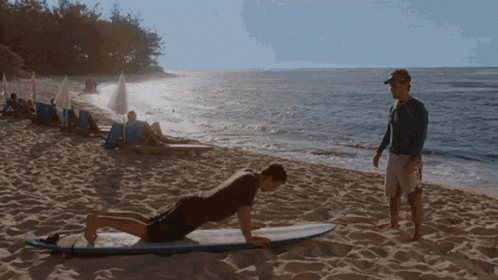The Summer of Knee Pain
As the summer of 2022 began, three professional athletes limped into Apiros: Amber Melville, Angelo Caloiaro, and Bri Gardner. All of them had left knee pain, and they all needed different programs. There are gaggles of gimmicky recipes about curing knee pain, but this summer proved that recipes often don’t work. Principles that adapt to the athlete do. The main principles I used are told through their stories below.
Amber Melville: The High Jumper (Who Refused To Bend Her Knee)
Amber jumps high. She used to jump higher, but knee pain brought her down, lowering her bar from 6'2" to 5'10". For the last five years, her left knee would flare up at the beginning of each season. As a former ACC champion (indoor and outdoor) and three-time All-American, these last few years were far below Amber’s potential as she struggled to clear six feet. Enough was enough.
Amber came to Apiros, and in about five weeks, we got her jumping pain-free again. Considering many people battle knee pain for several months and years, this was a huge win—but it's a normal outcome at Apiros. The real win (and challenge) was undoing the myriad substitutions Amber habituated over those five painful years.
The first thing I did was find a position where she could bend her knee without pain. That meant drastically lowering demand, getting creative, and asking her quad to work again but at the lowest of intensities. Check out the video below to see what I mean.
Amber progressed with the above light exercises until her pain improved and we could increase intensity. That’s when I asked her to start loading her knee with weight. But we had another obstacle: her brain had gotten too good at preventing knee pain by substituting hip movement for knee movement. Her knee could bend pain-free by now—but it didn’t. As you’ll see int he video below, I had to teach her how to bend her knee again.
Movement substitutions are astounding redundancies that allow people to keep moving and playing but are not long-term solutions—a limp is great when you’ve just sprained your ankle but terrible once it’s healed. The problem is that people don’t know how to remove these substitutions once they have healed. Most aren't even aware that they're using them to get around.
Removing Amber's movement substitutions was key but took a skilled eye. (I teach my students to see the body differently in my course.) Most athletes and coaches still just watch to see if the weight went from A to B, or if a muscle worked, and not how the bones actually move. How bones move is far more important because it dictates the adaptations of the muscles and tendons. Amber’s substitutions meant she didn’t actually load her quad and the connective tissue in her knee. Without loading those tissues, adaptations are impossible to come by. You’ll never strengthen your bicep if you refuse to bend your elbow. She had to bend her knee again.
This approach, removing pain and then substitutions, made Amber's knee feel great for the first time in half a decade. She finished the 2022 season without pain, but the real test will be making it through the entire 2023 season. So, this off-season, we will aggressively bolster her knee so she can finally have a season—or several—that she’s dreamt of having.
Angelo Caloiaro: Pro Basketball
Angelo has played in the Euro League for the last ten years. He’s had an incredibly healthy career compared to his peers—who often look like baby giraffes hoopin’ on ice. But in the middle of the 2021/22 season, Angelo’s left knee suddenly gave him problems. He did what he could to manage the pain, and tried everything that promised to “cure his knee pain,” but nothing worked.
When he walked into Apiros, even bending his knee in the air hurt. Yikes. I started the same way I did with Amber: creatively searching for any way to bend his knee without pain. We wound up, of all things, crawling. Yes, on his hands and knees. Like a baby, a 6’8” baby. But if you see past that, you’ll notice that crawling got him to bend and straighten his knee in near full ranges of motion. Crawling is like a single-leg squat. His quad had to work again after taking an involuntary sabbatical. It has nothing to do with “crawling” or oft romanticized baby movements, and everything to do with his quad working and putting healthy tension through his tendons.
Every week he improved, and every week I searched for new, sometimes untraditional movements that could challenge his knee with little to no pain. He was surprised that his pain decreased quickly because the movements were so odd, one of which he titled, “The Funky Flamingo,” but he couldn’t argue with the results and kept up the funk.
Within the wretchedly short window that is a modern off-season, Angelo went from avoiding his knee at all costs to being able to jump and land on his left leg without any precaution. Since athletes (like Angelo) don’t have time for a lot of trials and errors, I must be creative and expeditious in solving their problems. Athletes need decisions informed by good research but they do not have time for a twelve-week process that’s been outlined in the literature. They need a creative process that blends evidence and coaching expertise.
So with an extreme eye for detail, I batch several movement experiments into the few weeks athletes jailbreak from their wardens and sports. I need to get them results—fast. And I do, in most cases. It just looks different than the norm. As it should. Each athlete is a different person with different needs, histories, and goals.
Bri Gardner: Pro Volleyball
Bri Gardner is tough. Unfortunately, that trait meant she grinded through constant knee pain for five years. Five years! (Amber’s was off and on, depending on the time of year.) Within modern sports culture, she’s not the only one.
She is the product of a culture that fetishizes and trivializes pain. I understand the occasional need to push through pain, but man, there is one hell of an argument for low pain tolerance. Such sensitivity would promote healing, and adaptive behaviors at the first twinge of a problem rather than sucking it up for far too long. I digress…
Bri’s sessions reminded me that recipes rarely work with people who have chronic pain. What I did for Amber and Angelo did not work for Bri. I had to find a different entry point to pain-free knee movement, which was a movement that was effortless and as slow as molasses. “Do less,” I kept telling her. “Try less.” Basically, I was Paul Rudd in Forgetting Sarah Marshall teaching Jason Segel how to surf by doing nearly nothing. Eventually, she did next to nothing and we found our pain-free movement, our starting point.
She had three sessions in her first visit to Santa Cruz. Within that time, Bri found her spirit animal, the sloth, and moved so slowly that her knee pain dropped from an eight to between a zero and a three, depending on the day. After several weeks, she came back to Santa Cruz for her next phase. I experimented with a few different movements and we landed on high-intensity, short-range isometrics because of a few reasons. The primary one is that they made her knee feel better. The second one is that more and more research is pointing toward heavy, intense lifts for tendon health and rehab. I chose the shorter range, with less knee bend, because my experience shows that it has a high probability to work with sensitive cases like hers. (If anyone has a link to research about short ranges for tendon health or chronic pain, send it my way.)
Her knee pain is steadily declining. Slowly, but surely. If her knee stops improving, I will intervene with new experiments. But for now, we just need to be patient and respect the fact that her pain stewed, festered, and lingered for five years. (Nearly 2,000 days of pain.)
Lastly, sorry, Bri. You’re now Jason Segel and a sloth.
The One Commonality
While each of these three knees were unique, there were similarities in their owner’s choices. The one thing these athletes had in common is becoming more and more of a red flag: they stopped lifting heavy things. Heavy lifting is vital for tendon health. But it does need to be done well to make it beneficial instead of a risk.
Technically, people don’t need to lift heavy weights but can do something with high muscular demand, like a pistol squat, one-arm pull-up, or any of the odd, bodyweight variations you see on the Apiros Instagram that accomplish this intensity in novel ways.
This fact of tendon health is one reason why I try to get everyone I work with strong. Not powerlifter strong, that’s not going to help them become more athletic or injury-free, but “Apiros Strong.” Several Apiros athletes have separately come to that conclusion using those words because it’s such a common result of our style of training.
Athletes realize they are Apiros Strong in several ways: they try a hard lift they’ve never done before and are immediately capable, more than they predicted. They try a movement or lift they haven’t done in months, expecting it to be a challenge, but it’s a breeze. (Like Wes Schweitzer who takes months away from bench pressing and then out-benches the entire roster of the Washington Commanders.) Lastly, and most importantly, it means that none of their tendons ever bother them.
Each of these three athletes needed Evolved Coaching to build their unique starting points and programs. But as their knees felt increasingly better, their programs looked increasingly similar: lift heavy, load the knees, and get Apiros Strong in full ranges of motion.
Lastly and perhaps obviously, these athletes needed more than the simple principles outlined above. There were necessary nuances to each of their programs that are too long and complicated for a blog post but are appropriate for my course. If you want to know what those things are and take the course, click here to apply.
If your story is similar to any of these athletes, click here to contact us.
If you want blog posts like these sent directly to your email, click here.


